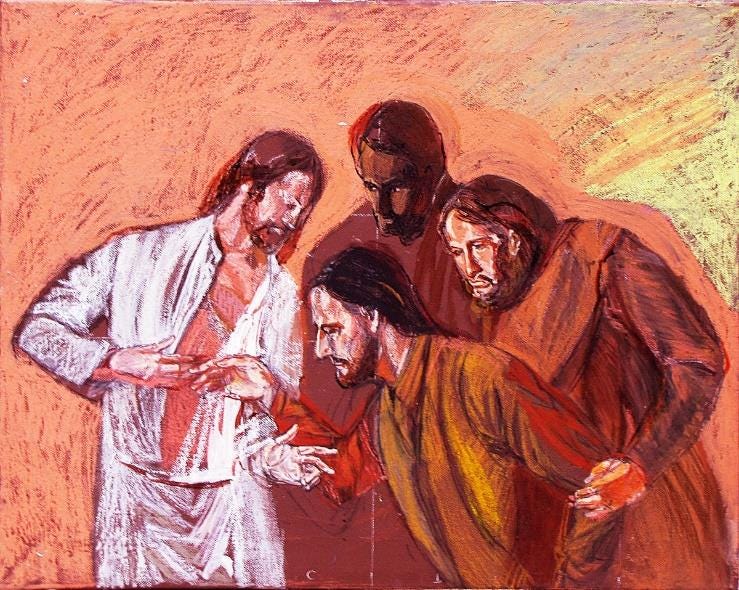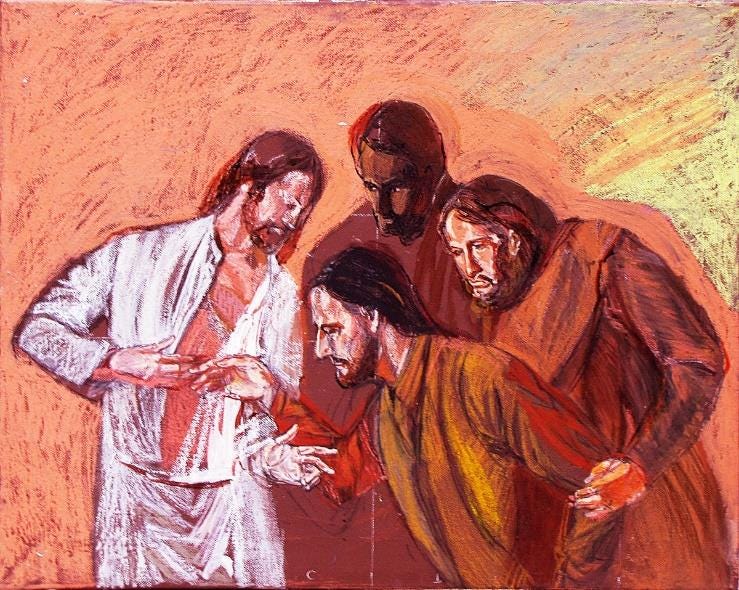This morning, we enter today’s gospel that has so much for us to take in. Where do we even begin? There’s almost too much happening to fit in one sermon. But, in sitting with this passage more and more, something sticks out. Jesus’s appearance to the disciples is not just about doubt or fear – but it’s also about grief.
This is about what happens when we have experienced life-changing, world-altering, and sometimes, painful and traumatic events. Yes, I know, we’re already in Easter, but hear me out.
See we don’t meet the disciples in a place of joy or wonder like last week, with Mary and the tomb.
Instead, we find the disciples crowded, locked in a room. We don’t know how many there are, but I imagine them packed, shoulder to shoulder, like smoked sardines in a tin, and as scripture tells us, fearful.
This is where our story begins.
And this is important – because the disciples weren’t at the crucifixion. They did I think what most human beings would do in dangerous situations, they ran. They ran to survive. But, I imagine that when they finally found a place to to be still, after the tomb was rolled shut, after the chaos, that reality began to set in. And I think about what happened in that room – what did they say to each other? What did they think? I imagine that the disciples talked with one another, probably argued and questioned, over and over again what had happened:
“What did Jesus just go through? Did they really pierce him? How badly was he wounded? What did he say?
And why weren’t we there?”
The questions are enough to shake anyone to their core – and the disciples were not spared from them. I imagine that in this room, they had to sit with fear, regret, and grief. Because their leader, their friend was dead.
And death does things to us, and by us, I mean those who witness it, who hear it, who experience it. The ones who get left behind, it does something to us. Death disrupts our sense of intimacy, tearing us apart from those we love and hold dear. Accepting that reality is no easy thing to do.
James Baldwin says,
“The greatest difficulty is to accept the fact that the man is dead. It is one thing to know that a friend is dead and another thing to accept, within oneself, that unanswering silence: that not many of us are able to accept the reality of death is both an obvious and a labyrinthine statement.”
I imagine this rung true for the disciples, contending with the reality that Jesus is dead, thick in their grief. AND SO – WHAT HAPPENS NEXT? What does Jesus do, knowing what the disciples must be feeling?
One might suggest that the Risen One will approach this tenderly, subtly even—
NOPE… Jesus just SHOWS UP.
Understandably, they’re startled, to say the least – so Jesus meets them where they are, greeting them with peace, and more importantly, he shows them his wounds. This is important. Yes, is it a little morbid, maybe gross to show the disciples the wounds? Maybe, but stay with me -- because I think what Jesus does is so deeply pastoral.
When we lose someone we care about and love, often we hear that a hole has been left in the heart, a hole where that person once was. And it’s a hole that is unfillable. A permanent wound, perhaps.
It’s easy to ignore them – we’re really good at hiding them too.
Because if we look at them too long, we can find ourselves falling into our wounds, falling deeply into our grief and finding no way out.
So yeah, maybe it’s better that we don’t pay too much attention to them.
But Jesus does something different. In offering his hands and side to the disciples, he does something new.
“Look at my hands, look at my side,” Jesus says to his followers.
“I need you to look.”
He doesn’t ask them to ignore the wounds, but he invites them to look in, to do the very thing that a grieving person wants to avoid, to see the pain.
And I imagine the disciples, crowded as they are, hesitant at first, begin to look, to peer together, gazing into Jesus’s hands and side, his wounds mirroring their own, and their gaze shifts, to see the risen Jesus.
Suddenly, it becomes clear: and they REJOICE. They are JOYOUS. And it is beautiful.
This Jesus, who has offered himself yet again, as wounded but whole, alive, living.
He shows us that these wounds are not the end, he offers the grieving a new way, reclaiming the wounds that we carry, and showing that yes, the wounds are there,
“Look at me,” Jesus says.
“Look at my body, yes I’m wounded, yes, I died” but also,
“Look at my body,
look at ME,
I am here.
I am here.”
I thought maybe here, this is where the sermon should end, because this is all tied up so neatly. Here we are, reminded of the power that the resurrection has over death, over grief… but…
There remains one final wrinkle:
Thomas.
“Doubting Thomas” – the title that history has bestowed upon him, as Oxford Dictionary defines: “a person who is skeptical and refuses to believe something without proof”. WHEW. Thomas, history wasn’t really kind to him, was it?
And yes, the story is clear about Thomas and Jesus – but I always seemed to empathize with Thomas. Not only did he lose his friend, his leader, but everyone else seemed to see Jesus before him – I too would have felt some type of way!!
Thomas is so insistent on seeing Jesus: “Unless I see the mark of nails in his hands and put my finger in the mark of the nails and my hand in his side, I will not believe."
Oh Thomas, you’re not making this easy– I want so bad to be on your side!!
But then I think about where Thomas is in the story – why wasn’t he there with the disciples a week ago? What must have he been feeling? Did he have a support system? Could he share his grief with someone? His pain?
I mean, it’s not like he didn’t want to see Jesus. If anything, it’s the opposite: he yearns for Jesus, he wants nothing more than to be close to him, to see him, to be with him.
Then… why is he seen as a doubter? Why has he become the cautionary tale for us believers? Perhaps, it’s because Thomas is almost TOO human. His actions are so to speak, too real to relate too and that makes us uncomfortable – because then we’re forced to see some pretty hard truths about ourselves.
I get it.
I would’ve doubted too. Who wouldn’t?
One doesn’t have to look far these days to see how hard it is to think differently after witnessing so much violence, death, erasure, and destruction over the last few years, months, weeks, and days.
In some ways, the doubt comes from our pains and our grief, because thinking otherwise feels too out of reach. How many of us have ever been so overwhelmed that any inkling of hope felt way too out of reach? Or seemingly impossible? EVEN when we believe otherwise? What are we supposed to do?
This is where Christ once again surprises us. Because instead of outright rebuking Thomas, he opens himself up, telling Thomas to come close to him, to look at his body as the disciples did, and peer into the wounds, to touch that flesh. And in that moment, something miraculous happens: God once again touches humanity, meets us in our pain, fear, and doubt, saying to us:
“Look at my body,
Look at my wounds,
But look closer,
look at me,
Look at me,
I am here.
I am here with you.”
And what does Thomas say?
MY LORD AND MY GOD.
An act of holy, hopeful declaration – the confirmation that we belong to the God of hope, the God of love and intimacy, the God of RESURRECTION.
This God, this God who was crucified, who knows our wounds, the pains we experience, and who brings us into new life, this God brings us closer — enveloping us in a cosmic and holy embrace that says, “I got you. I’m here.”
And yeah, sometimes its hard to trust those words, because yeah, sometimes we need to be able to touch, sometimes, we do need that physical hug. But Jesus reminds us that faithful trust is a practice, it is something that we work on, day by day. We will fail and succeed sometimes. But practice, is key. So how do we practice that today then, my friends?
Jesus again shows us the way – he offers his body, showing his scars and wounds, trusting us with the most tender parts of his being, inviting us into a new kind of closeness that shows us what it means to belong to each other.
Can we do the same today?
Can we see one another,
go into each other’s wounds and scars,
into those most tender places?
Can we do as Christ has done?
Reminding one another that they are seen and known,
that we belong to God and to one another.
Remember what Jesus does:
“Look at my body,
Look at my wounds,
look closer,
look at me,
Look at me,
I am here.
I am here with you.”
Let it be so.



